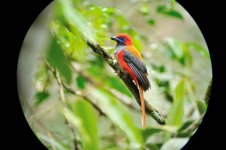vd Berg
Active member
Hello,
What is your experience with full frame digiscoping (preferably in non-optimal light conditions) with a focal length from 1.000mm? The purpose is digiscoping for identification photos at long distance (preferably in dim light) of a) small birds in high trees b) far-a-way waders. So, getting closer to the subject is not an option. ‘tac sharp’, ‘good/sharp detail’ photos are not intended.
With kind regards,
vd Berg
What is your experience with full frame digiscoping (preferably in non-optimal light conditions) with a focal length from 1.000mm? The purpose is digiscoping for identification photos at long distance (preferably in dim light) of a) small birds in high trees b) far-a-way waders. So, getting closer to the subject is not an option. ‘tac sharp’, ‘good/sharp detail’ photos are not intended.
With kind regards,
vd Berg





